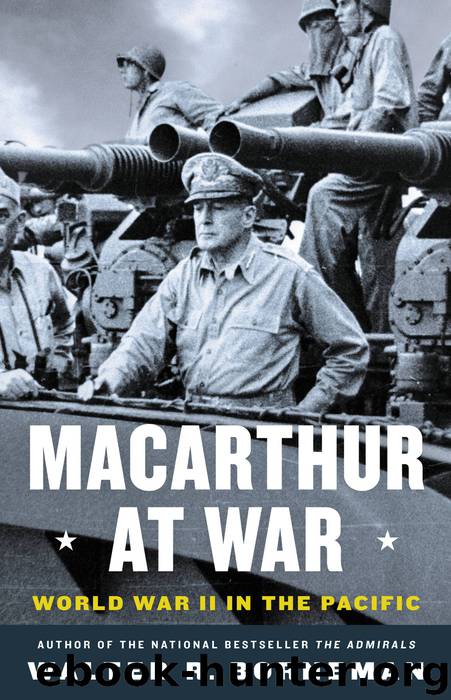MacArthur at War by Walter R. Borneman

Author:Walter R. Borneman
Language: eng
Format: epub
Tags: History / Military / World War Ii, History / Military / United States, History / Military / General, History / General
Publisher: Little, Brown and Company
Published: 2016-05-09T16:00:00+00:00
CHAPTER SIXTEEN
Bypassing Rabaul
The World War II strategy of island-hopping—isolating and bypassing enemy strong points—had many fathers. The Japanese, consciously or not, employed a version of it when they left MacArthur and some eighty thousand troops on Corregidor and Bataan. They rushed past to attack the East Indies and reach their goal of an unfettered supply of natural resources. When the North Pacific Force directed its assault against Japanese-occupied Attu, in the Aleutians, in May of 1943 after bypassing what was thought to be more heavily defended Kiska, they made the first American use of the strategy in the Pacific. The fact that Attu proved a buzz saw of opposition, and the fact that the Japanese later abandoned Kiska without a ground fight, in no way dissuaded planners from looking for similar opportunities to employ island-hopping as a strategic concept.
The idea of recapturing Rabaul, on New Britain, had been ingrained in Allied thinking since the Japanese wrestled it away from Australian forces early in 1942. MacArthur was a vocal proponent of the absolute necessity of doing so. He was clearly headed in that direction before the Japanese disrupted his plans by occupying Buna and forcing him to fight for Papua.
By the early summer of 1943, in the broad context of Aleutians operations and the debate between a central Pacific and southwestern Pacific advance, Washington planners began to ponder the economies that might result if Rabaul were neutralized rather than taken in a direct and likely prolonged assault. Doing so would benefit both Nimitz and MacArthur by permitting those resources to be allocated elsewhere in their respective theaters. The Joint Strategic Survey Committee came to favor the proposed central Pacific operations over Rabaul-bound Operation Cartwheel. Not only did the committee worry that the drive against Rabaul was, strategically speaking, merely a pushback against Japanese thrusts into the Solomons and at Buna, they also worried that it held “small promise of reasonable success in the near future.”1
By July 21, these staff discussions about isolating Rabaul had set George Marshall to thinking. He suggested to MacArthur that the ultimate objective of the Cartwheel operations be modified. Instead of assaulting Rabaul directly, why not encircle it and render it useless by capturing Kavieng, on the northern tip of New Ireland, and Manus, one of the Admiralty Islands? Marshall also suggested capturing Wewak, northwest of Lae, to spur the drive westward along the coast of New Guinea. This meant that MacArthur had to seize Lae, continue operations westward along the New Guinea coast, and bypass Rabaul rather than meet Halsey there.2
MacArthur was not convinced. He argued that a direct assault against Wewak would involve “hazards rendering success doubtful.” Interestingly enough, however, in rejecting the attack against Wewak, MacArthur did not propose to advance steadily toward it from Lae but rather to jump over it and seize a base farther west from which to isolate Wewak—exactly the sort of strategy Marshall was proposing against Rabaul. As for Rabaul itself, MacArthur remained of the mind that it would
Download
This site does not store any files on its server. We only index and link to content provided by other sites. Please contact the content providers to delete copyright contents if any and email us, we'll remove relevant links or contents immediately.
| Afghan & Iraq Wars | American Civil War |
| American Revolution | Vietnam War |
| World War I | World War II |
Waking Up in Heaven: A True Story of Brokenness, Heaven, and Life Again by McVea Crystal & Tresniowski Alex(37028)
Empire of the Sikhs by Patwant Singh(22195)
We're Going to Need More Wine by Gabrielle Union(18095)
Hans Sturm: A Soldier's Odyssey on the Eastern Front by Gordon Williamson(16913)
Leonardo da Vinci by Walter Isaacson(11934)
The Radium Girls by Kate Moore(10933)
Educated by Tara Westover(7090)
Tools of Titans by Timothy Ferriss(6983)
How to Be a Bawse: A Guide to Conquering Life by Lilly Singh(6713)
The Last Black Unicorn by Tiffany Haddish(5087)
Permanent Record by Edward Snowden(5018)
The Rise and Fall of Senator Joe McCarthy by James Cross Giblin(4854)
Promise Me, Dad by Joe Biden(4463)
The Wind in My Hair by Masih Alinejad(4435)
The Crown by Robert Lacey(4122)
A Higher Loyalty: Truth, Lies, and Leadership by James Comey(4047)
The Iron Duke by The Iron Duke(3659)
Joan of Arc by Mary Gordon(3275)
How to be Champion: My Autobiography by Sarah Millican(3199)
